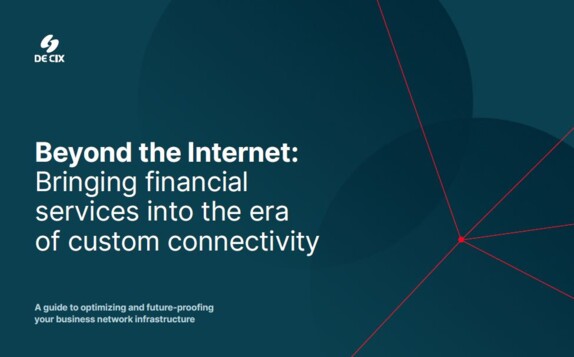Cloud adoption is accelerating in the finance sector as changing customer expectations push banks and other financial institutions to emulate the speed, agility, scalability, and efficiency of cloud-native organizations. But while cloud adoption is highly beneficial, it does raise the risk of cloud concentration. So if you're looking to adopt a multi-cloud strategy supported by resilient connectivity, this checklist outlines four capabilities you must be able to tick off in order to mitigate this risk.
Mitigating cloud concentration risk: A checklist for the finance industry


Distributed infrastructure
A distributed infrastructure mitigates risk while maximizing resilience. With multiple connection points, including clouds and data centers, a distributed infrastructure has no single point of failure, delivering high fault tolerance, strong reliability, and fast recovery. As a distributed platform acts like a single system to process tasks and share resources, you also benefit from simplicity and transparency.
A distributed infrastructure also enables physically separated on-ramp locations, providing different points across the world where your organization can jump into the cloud network. When combined with the cloud service provider’s ability to replicate data and workloads in multiple physical locations, this allows your services to be restored quickly if there is a situation or outage in one region.
Provider diversity
A multi-cloud strategy naturally requires the use of multiple cloud providers to avoid over-reliance. If you need global coverage, this is sure to include one or more of the big players such as AWS, Google Cloud, Microsoft Azure, IBM Cloud, and Oracle, or possibly Alibaba or Tencent. Your organization may also benefit from adding regional cloud providers to the mix, as well as smaller private cloud providers.
But it’s not just the cloud providers themselves where you need diversity. You also need a range of neutral carriers and data center providers with infrastructure that is independent of the cloud service provider. Concentration with any one provider increases risk, so you must ensure diversity across the board.


True redundancy everywhere
No doubt you already understand the importance of redundant pathways, allowing data to take an alternative route when one fails. But a fully redundant implementation is about more than just pathways. If the data handover for multiple redundant pathways is executed on a single device, for instance, all pathways will fail when that device fails.
Redundancy needs to be applied throughout – at access points, data centers, and carriers, not just specific pathways. And configuration must also be carefully considered. If otherwise redundant paths cross virtual connections in one data center, that still creates a single point of failure.
Stable and secure connections
An effective multi-cloud strategy requires a secure and stable connection to cloud service providers, to enable fast access to workloads running in the cloud. A direct and dedicated connection between financial services infrastructure and cloud service providers minimizes downtime and latency.
And it’s not just the connection from your own infrastructure to the cloud that you need to consider. Clouds often need to talk to each other, for instance when a workload running in Microsoft Azure must pull data from AWS, so cloud-to-cloud connectivity will need to be a greater focus moving forward.

A distributed cloud exchange
With cloud adoption accelerating in the finance sector, and over-reliance on a single provider likely to be a greater regulatory concern moving forward, now is the time to address cloud connectivity. A distributed cloud exchange platform with secure connectivity can deliver these four components, supporting an effective multi-cloud strategy and mitigating cloud-concentration risk.
To make a multi-cloud environment even simpler to manage, you can use a distributed cloud exchange platform with a self-service portal and API automation. This gives you the flexibility to book bandwidth as and when it is required, and automatically scale in times of unexpected need.

This checklist is available as a sharable pdf
Why is cloud concentration risky?
The cloud has become essential to the smooth running of any modern businesses. In addition to speed and scalability, it enables an increasingly mobile workforce to access data and resources wherever they are located. It also allows businesses to connect with the latest AI and analytics tools and capabilities, and to implement strong disaster recovery and business continuity plans.
While security was once a concern, most organizations are now confident the tools and processes implemented in cloud infrastructure can deliver robust protection. In fact, many are realizing their critical data and workloads might actually be far safer in the cloud than stored in one specific location.
There is an increasing risk of of cloud concentration, where key financial services become overly reliant on one specific cloud service provider.
Whether it’s Deutsche Bank and Google Cloud, UBS and Microsoft Azure, or BNP Paribas and IBM Cloud, many financial institutions have close relationships with single cloud service providers.
Financial regulators are increasingly concerned about cloud concentration, fearing disruption and instability across the global financial system could stem from an outage or cyber attack on one cloud.
Cloud service providers suggest risk can be reduced by distributed computing and diversifying within a single cloud environment. But regulators are yet to be convinced and financial services companies must take the strategic decision to mitigate risk and avoid having a single point of failure.
Adopting a multi-cloud strategy is the obvious answer to over-reliance on a single provider. Many financial institutions are already exploring this option, which allows them to select services from multiple cloud service providers and mitigate risk, while still driving innovation.
Using multiple clouds is not, in itself, a complete solution. Financial institutions can’t easily switch between cloud providers, so individual workloads and applications are still siloed on single clouds. Spreading workloads across multiple clouds is also seen as a complex task.
A further step is required to enable cloud-to-cloud communication and automation of interconnection, which will streamline the multi-cloud approach.
To mitigate the risk of cloud concentration, and simplify the management of workloads running across multiple clouds, financial institutions need secure, automated, resilient interconnectivity through a cloud exchange to support their multi-cloud strategies.
Connectivity to and between cloud service providers is often overlooked, but its resilience is essential to ensure services can be up and running quickly in the event of an outage or attack.
Ready for customized connectivity?
If you're ready to take your business connectivity to the next level and future-proof your network infrastructure, take a look at our Beyond the Internet ebook. You'll find out how to leverage connectivity customized for your unique business requirements, including creating private connections to multiple cloud service providers.
